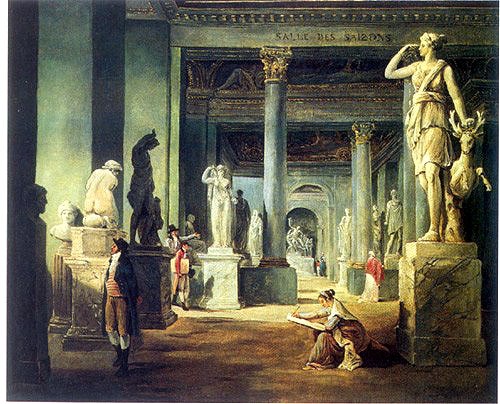In September 1803, the 'Muséum central des arts', renamed the Musée Napoléon (today's Louvre), opened its doors to the public, after a new series of exhibition rooms had been built containing some of the most famous statues from antiquity. It was on a suggestion of Cambacérès, in a letter to Vivant Denon dated 22 June, 2003, that the Museum was to receive its new name: “the best title for this most precious collection is the name of the hero to whom we owe it. I believe that I am expressing the wishes of the nation in authorising you to put as an inscription in the frieze which dominates the entrance these words: “Musée Napoléon“.
Inaugurated on 10 August, 1793, the 'Muséum central des arts' was set in the Louvre palace. Here, the royal collection and the works confiscated from the clergy and the exiled aristocracy were soon to be joined by the booty seized during the military campiagns of the initially Revolutionary but later Napoleonic armies. In 1795, a decision was made to create a Museum of Antiquities in what had been the apartment of Anne of Austria, but the work was to last five years since the gallery would not to be completed until November 1800, when it was inaugurated in the presence of the First Consul and his wife.
This Museum of Antiquities was arranged along two perpendicular axes, and Hubert Robert here shows us the first part, in effect a series of named halls or salles, the Salle des Saisons (the hall of the seasons), the Salle des Hommes illustres (the hall of great men), and the Salle des Romains (the hall of the Romans), which gave onto the Salle du Laocoon [pronounced Lay -o -co -on]. Here set into a niche stood the famous sculpture group taken from the Vatican (to which it was subsequently returned and where it stands today) showing the scene from Virgil's Aeneid where the priest Laocoon and his two sons are devoured by sea serpents. The sculpture can just be seen in the background of the painting.
A painter and engraver of pre-Romantic tendancies, Hubert Robert had been in charge of the paintings in the Royal collection before the Revolution, and in this post he had several times planned the installation of the museum in the Louvre. As a result, he here gives free rein to his imagination for his 'museum palace', painting romantic ruins and perspectives plunging deep into the Grande Galerie. On a less poetic level, this picture gives a good idea of who was coming to the museum towards the end of the Consulate, namely amateur enthusiasts and copyists. It also shows the grandiose nature of the Musée Napoléon (dismantled in 1815). Given the extraodinary concentration of unique masterpieces, Vivant Denon, the museum's director, described it as a “colossus which will become yet more gigantic in the imagination”.
Karine Huguenaud (tr. P.H.)
September 2003
The Salle des Saisons’ in the Louvre
Artist(s) : ROBERT Hubert

- Date :
- 1802-1803
- Technique :
- oil on canvas
- Dimensions :
- H = 0.37 m, L = 0.46 m
- Place held :
- Paris, Musée du Louvre

